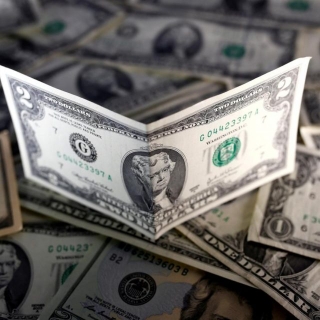


The dollar rose in early Asian trade on Monday after weekend talks between the United States and China eased fears of a trade war between the world's two largest economies while global hot spots appeared to cool.
The dollar, government bonds and equities have been battered since massive tariffs announced by US President Donald Trump last month shook confidence in American assets. After talks in Geneva, Treasury Secretary Scott Bessent and Trade Representative Jamieson Greer said Sunday a deal had been reached with China to cut the US trade deficit.
More details are expected on Monday. Attention will also be on US earnings and data this week, including the consumer price index (CPI) figure on Tuesday, for indications of how much damage the trade war has done to the economy. "Early signs from the interbank FX trade support USD longs, certainly against CHF, JPY and EUR, and we head into US core CPI and retail sales with USD support," Chris Weston, head of research at Pepperstone, said in a note.
"We head into US core CPI and retail sales with USD support," he added.
India and Pakistan declared a ceasefire over the weekend after four days of fighting between the nuclear-armed powers that rattled markets. And Ukrainian President Volodymyr Zelenskiy said he was ready to meet Russian leader Vladimir Putin in Turkey on Thursday for direct talks, their first since the early months of the 2022 invasion.
The dollar index rose 0.2% in early Asian trade, still down 3.6% from Trump's April 2 "Liberation Day" tariff announcement.
The U.S. currency rose 0.3% to 145.85 yen. The New Zealand dollar, a common proxy for risk assets, rose 0.2% to $0.5921. The euro was at $1.1226, down 0.20% so far in Asia. The Australian dollar was at $0.6424, up 0.19% in early trade. (Newsmaker23)
Source: Reuters
The dollar headed for its worst week since late July on Friday (October 3rd) as the US government shutdown heightened uncertainty, while the yen weakened from this week's high as traders considered th...
The dollar weakened near a one-week low on Thursday as traders weighed the impact of the US government shutdown, while poor jobs data raised expectations that the Federal Reserve would cut interest ra...
The U.S. dollar slid to two-week lows against the yen on Wednesday after data showed private-sector jobs in the world's largest economy contracted last month, boosting expectations the Federal Reserve...
The dollar index fell to its lowest level in the session as U.S. corporate payrolls unexpectedly fell in September and traders increased bets on two interest rate cuts by the Federal Reserve this year...
The US dollar continued to weaken, approaching its lowest level in a week as uncertainty over a possible US government shutdown looms. If the US government does shut down, the release of key data, suc...
Japanese stocks rise due to growing hopes that newly elected ruling-party leader Sanae Takaichi will take more aggressive fiscal steps to stimulate the economy. Heavy-industry and real-estate stocks lead gains. IHI rises 5.3% and Sumitomo Realty...
Gold strengthened early in the Asian session. This rise aligns with the upward trend in commodities, driven by macroeconomic uncertainty, a weakening dollar, and continued strong demand for hard assets. According to City Index and FOREX.com analyst...
Gold rises in the early Asian trade. There's a broad commodities uptrend, driven by macro uncertainty, a weaker dollar, and persistent demand for "hard" assets, says Fawad Razaqzada, market analyst at City Index and FOREX.com, in an email. "Gold's...
 Asian stocks surged to new highs, led by Japan's Nikkei 225, which surged more than 4% following the election of pro-stimulus lawmaker Sanae...
Asian stocks surged to new highs, led by Japan's Nikkei 225, which surged more than 4% following the election of pro-stimulus lawmaker Sanae...
 Hamas officials were in Egypt on Monday (October 6th) ahead of talks with Israel that the US hopes will lead to an end to the war in Gaza and the...
Hamas officials were in Egypt on Monday (October 6th) ahead of talks with Israel that the US hopes will lead to an end to the war in Gaza and the...
 Euro Area Stock MarketEuropean stocks closed mostly lower on Monday as fresh political turmoil in France rekindled concerns of fiscal instability...
Euro Area Stock MarketEuropean stocks closed mostly lower on Monday as fresh political turmoil in France rekindled concerns of fiscal instability...
 The S&P 500 and Nasdaq Composite closed at record highs on Monday, spurred by optimism about increased mergers and acquisitions activity after...
The S&P 500 and Nasdaq Composite closed at record highs on Monday, spurred by optimism about increased mergers and acquisitions activity after...